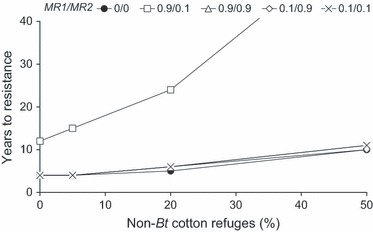Figure 4.

Effect of the abundance of sprayed refuges of non-Bt cotton (%) on the evolution of Helicoverpa armigera resistance to Cry1Ac/Cry2Ab cotton at Djalingo (Cameroon). Simulations considered data on movement between non-cotton refuges and cotton fields and patterns of long-range migration (Fig. 2). For Cry2Ab, the initial resistance allele frequency was 0.0033, and resistance was semi-dominant (DLC = 0.5). For Cry1Ac, initial resistance allele frequency was 0.0003, and resistance was partially recessive (DLC = 0.26) (Table 2). MR1 is the proportion of moths from southern regions colonizing the cotton belt in June–July; MR2 the proportion of moths from the cotton belt contributing to the pool of migrants moving south in October–November. The criterion for resistance evolution was >20% survival on Bt cotton. Results of simulations for MR1/MR2 values of 0/0 were almost identical to results obtained for 0.9/0.9, 0.1/0.9 and 0.1/0.1.
